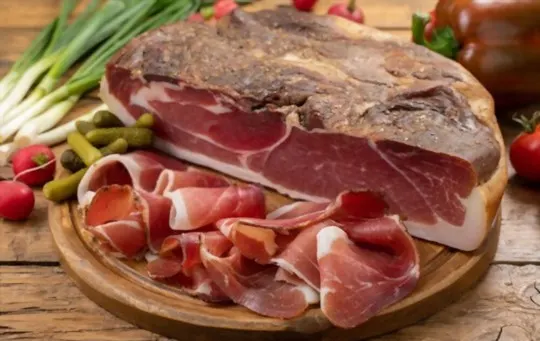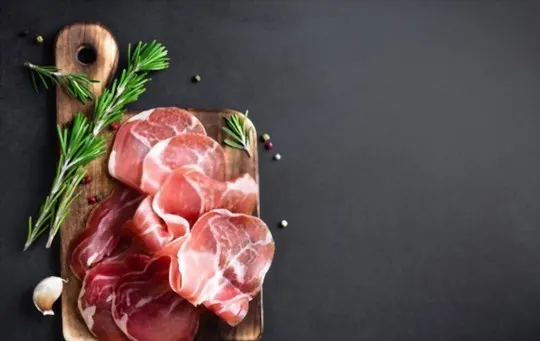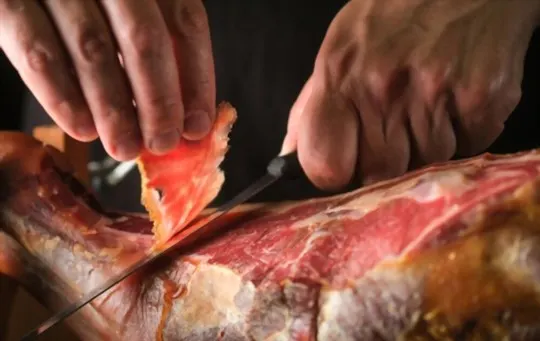In the battle of cured meats, two giants stand tall. Speck and prosciutto. These aren’t just snacks. They’re slices of heaven that have sparked debates in kitchens worldwide.
We’ve all been there. Standing in the grocery aisle, staring at them. Wondering.
Speck, hailing from the Alps, brings a smoky whisper to the palate. Prosciutto, on the other hand, is the smooth operator from Italy, offering a sweet, melt-in-your-mouth experience. It’s a culinary tug-of-war.
I once made a sandwich with both, thinking I could declare a victor. Spoiler: I couldn’t. It was like choosing a favorite child.
Now, we’re not here to stir the pot. We’re here to give you the lowdown on these two. No fluff, just the good stuff.

What is Speck?

With its roots in the Italian region of Trentino-Alto Adige, speck is a cured and smoked meat that has gained popularity in recent years.
Made from pork hindquarters, speck has a distinct flavor that sets it apart from other meats.
It is delicately smoked over beechwood for several months to help cure it and give it a unique taste.
Speck is not just any type of cured meat; this culinary delight requires skill and patience.
Unlike prosciutto, which relies on only salt for curing, speck benefits from some extra flavors like herbs and spices.
Its rich smoky aroma and slightly salty taste make it an excellent addition to charcuterie boards or any dish that needs a flavorful kick.
What sets speck apart from prosciutto is the smoking process.
The intense smoke flavor makes it stand out among cured meats, adding depth to its already delicious taste.
Additionally, while similar in texture, speck’s incredible flavor pairs well with hearty vegetables like cabbage or potatoes.
What is Prosciutto?

Prosciutto is an Italian dry-cured ham that is widely popular in the culinary world.
This pork leg meat is typically sliced thinly and has a unique savory flavor with a buttery texture.
Unlike regular bacon or ham, prosciutto undergoes a curing process for several months to gain its distinctive taste.
The traditional method involves adding sea salt to the meat and air-drying it in special cool and ventilated rooms.
This process imparts a rich umami flavor that makes prosciutto a gourmet ingredient in various dishes such as pizzas, salads, and sandwiches.
Differences Between Speck and Prosciutto

Speck and Prosciutto are two types of cured meat that have their own set of unique characteristics.
While both are made from pork, they differ in terms of flavour, texture, and production method.
Speck has a smokier taste and is usually made from the hind leg of the pig, while prosciutto has a sweeter taste and is typically made from the pig’s thigh.
Additionally, Speck is smoked before it is cured, whereas prosciutto is air-dried for an extended period.
Both meats can be enjoyed on their own or used as ingredients in various dishes ranging from pizzas to pastas to charcuterie boards.
Origin and Regional Variations
This article examines the geographical regions and historical origins of Speck and Prosciutto.
These two cured meats belong to the European tradition of dry curing ham, with each having its distinct cultural identity.
Speck from Tyrol region in Austria was traditionally smoked over beechwood chips for several months, whereas Prosciutto di Parma from Emilia-Romagna in Italy undergoes an extended curing process that produces a sweet, delicate flavor.
Apart from their origin and regional variations, these meats also differ in their production methods, ingredients used, and flavor profile.
Speck is salted, cured with spices like juniper berries, garlic or bay leaves before undergoing a cold-smoking process that gives it a distinct smoky flavor.
In contrast, Prosciutto is made with only pork leg along with sea salt as an ingredient.
Its aging process produces a nutty, buttery flavor.
In addition to Tyrol and Emilia-Romagna regions producing these meats for decades with traditional methods, other regions have adapted these creations to suit local preferences.
For instance, Speck-like Dried Jingdong Pork is widely consumed in China’s Yunnan province.
Similarly, Jamón serrano has become Spain’s version of cured ham derived from Presunto (Portuguese cured ham) but originated in Italy.
Overall both dried meats are revered delicacies loved by deli lovers worldwide but which one is better depends on individual taste preference and characteristics like texture-solid v/s fatty, color-light v/s dark among others that one prefers over the other.
Curing and Smoking Process
The meticulous preparation of cured and smoked meats is a delicate process that involves both art and science.
The meat must be seasoned, dried, and smoked to achieve the complex flavor and texture profiles that are characteristic of both speck and prosciutto.
Through the curing process, salt removes moisture from the meat while seasoning it with various herbs and spices.
Following this, it follows by smoking which imparts the unique smoky flavor to these meats.
When comparing speck vs prosciutto, one key difference is the type of pig used for each variety.
Prosciutto is made from the hind leg of an Italian pig called a Large White, while speck uses a different breed from Austria called Tyrolean Gray pigs.
The curing period determines their flavors as prosciutto has a more savory taste because it undergoes a longer drying period compared to speck.
Additionally, speck is typically lightly smoked over hardwood chips for several hours compared to prosciutto which may be heavily smoked for up to a month.
One aspect worth noting about these deliciously cured and smoked pork products is that they are not interchangeable in recipes due to their distinct flavors and textures.
Therefore, it’s essential to understand how each product works best in dishes when selecting one or the other in cooking applications such as pizza toppings or charcuterie boards.
Flavor Profile and Taste
The sensory experience of Speck and Prosciutto is a result of the complex interactions between aroma, taste, and texture.
Each has a unique flavor profile that varies based on factors such as curing time and ingredients used.
However, both are known for their delicate smoky taste and melt-in-your-mouth texture that makes them popular among meat lovers.
When it comes to flavor intensity, Speck tends to be stronger in taste than Prosciutto due to its longer smoking time.
The curing process also affects the flavor profile of each product.
While Speck is seasoned with aromatic spices such as Juniper berries and rosemary, Prosciutto relies on minimal ingredients, mostly salt.
Texture-wise, Prosciutto has a softer consistency that easily melts in your mouth.
On the other hand, Speck has a firmer texture that requires some chewing which brings out its complex flavors.
In summary, these distinctive qualities would appeal differently depending on one’s preference and intended usage.
Both delicacies serve as excellent additions to charcuterie boards or savory dishes.
Therefore it’s up to you to pick your favorite between these two cured meats’ delicacies based on flavor profile or texture preference.
Texture and Fat Content
When it comes to comparing speck and prosciutto, one of the key factors to consider is their mouthfeel and levels of fat.
Both meats are cured using traditional styles, but they vary in texture and fat content.
Speck has a firmer texture and slightly higher fat content than prosciutto.
Speck is made by first smoking, then air-curing pork belly for several months.
The smoking process gives it a deep smoky flavor while the curing process concentrates its flavors.
Prosciutto, on the other hand, is made from salt-cured ham that might be aged for up to 18 months.
It has a silkier texture than speck due to a lower fat content.
Moreover, based on individual preferences, each meat can serve different purposes in cooking or pairing with specific dishes.
While speck’s firm texture makes it perfect for use as a topping or garnish on salads and roasted vegetables, its high-fat content allows it to be used as an ingredient in pasta dishes or casseroles where melted fat enhances flavor.
Prosciutto pairs well with fruit and cheese platters because of its delicate and silky texture.
Similarities Between Speck and Prosciutto

Both speck and prosciutto are dry-cured Italian meats that share many similarities.
They are made from pork and seasoned with salt, but they differ in the preparation method.
Speck is smoked using wood chips and juniper, while prosciutto is air-dried.
Both meats have a distinct smoky, salty flavor and are often used as charcuterie or pizza toppings.
Additionally, they offer health benefits as they are high in protein, vitamins, and minerals like Iron.
Usage and Culinary Applications
Speck and prosciutto are both popular cured meats.
The uses and culinary applications of these two meats differ, with distinct flavors and textures.
Speck is commonly used as a pizza topping or in sandwiches, while prosciutto is mostly served as an appetizer or as a component in salads.
Both foods can also be utilized in cooking, with speck being paired well with pasta dishes and soups while prosciutto is often added to savory dishes like risottos.
In terms of texture, speck is thicker than prosciutto, making it suitable for grilling or frying.
It’s important to note that the choice between speck and prosciutto ultimately depends on personal preference, as they both have their unique flavor profiles and applications.
As always, consider the dish you are making before deciding on which one to use.
Selecting and Serving Speck and Prosciutto
When it comes to cured meats, choosing between Speck and Prosciutto can be a tricky task.
Both are Italian-style hams that offer an intense flavor, but they also differ in distinct ways.
To select and serve the perfect ham cut for your dish, consider its texture, intensity of taste, and fat content.
Speck is a dry-cured meat made from pork leg’s rear part and has a smoky flavor due to its smoked preparation process.
It has a firmer texture than prosciutto, making it ideal for sandwich recipes while pairing well with cheeses like gorgonzola or blue cheese.
On the other hand, Prosciutto has a delicate texture that melts in the mouth, making it suited for dishes like salads or wrapped around fruits like melon.
Its salty and sweet taste means it pairs well with sweeter wines such as Moscato d’Asti.
Apart from these differences, another factor to consider is their fat content.
Speck has more fat than Prosciutto due to its preparation process; alternatively, choose prosciutto with less fat if you prefer low-fat foods.
Ensure you store both cuts appropriately before serving to make them tender enough for your dish.
Choose your ham cut depending on your cuisine preference – firmness vs tenderness or smoky vs delicacy – and enjoy an authentic Italian-style meal.
Health Considerations
Maintaining a healthy diet involves making the right food choices.
When selecting between Speck and Prosciutto, certain health considerations need to be accounted for.
Both are cured meats, but their nutrient content may differ depending on various other factors such as processing and fat content.
While Speck is a smoked ham that originates from the Tyrol region, Prosciutto is an Italian dry-cured ham.
They both contain significant amounts of protein and fat, but Prosciutto has lower fat content than Speck and is available in leaner varieties.
It is important to note that consuming high amounts of processed meat such as Speck can increase the risk of developing cardiovascular disease or certain types of cancer.
On the other hand, moderate consumption of Prosciutto also has its benefits because it is rich in monounsaturated fats which help lower cholesterol levels.
Therefore, when considering health factors for cured meat selection, it can be concluded that moderate consumption of leaner Prosciutto varieties may be a better option than consuming higher fat content Speck.
Conclusion
Comparing Speck and Prosciutto, it is clear that both are excellent options.
Speck stands out for its smoky flavor due to being smoked with juniper berries.
On the other hand, Prosciutto is salty with a slightly sweet taste due to its lengthy curing process.
Both meats can be used as toppings or eaten on their own.
In terms of nutrition, Prosciutto has lower fat content compared to Speck, making it a better option for those watching their calorie intake.
However, Speck contains more protein and iron than Prosciutto, which could make it a better choice depending on individual dietary needs.
